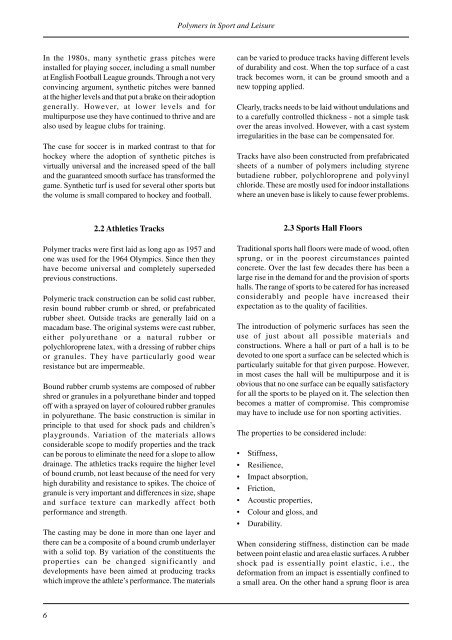Polymers in Sport and Leisure
Polymers in Sport and Leisure
Polymers in Sport and Leisure
Create successful ePaper yourself
Turn your PDF publications into a flip-book with our unique Google optimized e-Paper software.
<strong>Polymers</strong> <strong>in</strong> <strong>Sport</strong> <strong>and</strong> <strong>Leisure</strong><br />
In the 1980s, many synthetic grass pitches were<br />
<strong>in</strong>stalled for play<strong>in</strong>g soccer, <strong>in</strong>clud<strong>in</strong>g a small number<br />
at English Football League grounds. Through a not very<br />
conv<strong>in</strong>c<strong>in</strong>g argument, synthetic pitches were banned<br />
at the higher levels <strong>and</strong> that put a brake on their adoption<br />
generally. However, at lower levels <strong>and</strong> for<br />
multipurpose use they have cont<strong>in</strong>ued to thrive <strong>and</strong> are<br />
also used by league clubs for tra<strong>in</strong><strong>in</strong>g.<br />
The case for soccer is <strong>in</strong> marked contrast to that for<br />
hockey where the adoption of synthetic pitches is<br />
virtually universal <strong>and</strong> the <strong>in</strong>creased speed of the ball<br />
<strong>and</strong> the guaranteed smooth surface has transformed the<br />
game. Synthetic turf is used for several other sports but<br />
the volume is small compared to hockey <strong>and</strong> football.<br />
can be varied to produce tracks hav<strong>in</strong>g different levels<br />
of durability <strong>and</strong> cost. When the top surface of a cast<br />
track becomes worn, it can be ground smooth <strong>and</strong> a<br />
new topp<strong>in</strong>g applied.<br />
Clearly, tracks needs to be laid without undulations <strong>and</strong><br />
to a carefully controlled thickness - not a simple task<br />
over the areas <strong>in</strong>volved. However, with a cast system<br />
irregularities <strong>in</strong> the base can be compensated for.<br />
Tracks have also been constructed from prefabricated<br />
sheets of a number of polymers <strong>in</strong>clud<strong>in</strong>g styrene<br />
butadiene rubber, polychloroprene <strong>and</strong> polyv<strong>in</strong>yl<br />
chloride. These are mostly used for <strong>in</strong>door <strong>in</strong>stallations<br />
where an uneven base is likely to cause fewer problems.<br />
2.2 Athletics Tracks<br />
Polymer tracks were first laid as long ago as 1957 <strong>and</strong><br />
one was used for the 1964 Olympics. S<strong>in</strong>ce then they<br />
have become universal <strong>and</strong> completely superseded<br />
previous constructions.<br />
Polymeric track construction can be solid cast rubber,<br />
res<strong>in</strong> bound rubber crumb or shred, or prefabricated<br />
rubber sheet. Outside tracks are generally laid on a<br />
macadam base. The orig<strong>in</strong>al systems were cast rubber,<br />
either polyurethane or a natural rubber or<br />
polychloroprene latex, with a dress<strong>in</strong>g of rubber chips<br />
or granules. They have particularly good wear<br />
resistance but are impermeable.<br />
Bound rubber crumb systems are composed of rubber<br />
shred or granules <strong>in</strong> a polyurethane b<strong>in</strong>der <strong>and</strong> topped<br />
off with a sprayed on layer of coloured rubber granules<br />
<strong>in</strong> polyurethane. The basic construction is similar <strong>in</strong><br />
pr<strong>in</strong>ciple to that used for shock pads <strong>and</strong> children’s<br />
playgrounds. Variation of the materials allows<br />
considerable scope to modify properties <strong>and</strong> the track<br />
can be porous to elim<strong>in</strong>ate the need for a slope to allow<br />
dra<strong>in</strong>age. The athletics tracks require the higher level<br />
of bound crumb, not least because of the need for very<br />
high durability <strong>and</strong> resistance to spikes. The choice of<br />
granule is very important <strong>and</strong> differences <strong>in</strong> size, shape<br />
<strong>and</strong> surface texture can markedly affect both<br />
performance <strong>and</strong> strength.<br />
The cast<strong>in</strong>g may be done <strong>in</strong> more than one layer <strong>and</strong><br />
there can be a composite of a bound crumb underlayer<br />
with a solid top. By variation of the constituents the<br />
properties can be changed significantly <strong>and</strong><br />
developments have been aimed at produc<strong>in</strong>g tracks<br />
which improve the athlete’s performance. The materials<br />
2.3 <strong>Sport</strong>s Hall Floors<br />
Traditional sports hall floors were made of wood, often<br />
sprung, or <strong>in</strong> the poorest circumstances pa<strong>in</strong>ted<br />
concrete. Over the last few decades there has been a<br />
large rise <strong>in</strong> the dem<strong>and</strong> for <strong>and</strong> the provision of sports<br />
halls. The range of sports to be catered for has <strong>in</strong>creased<br />
considerably <strong>and</strong> people have <strong>in</strong>creased their<br />
expectation as to the quality of facilities.<br />
The <strong>in</strong>troduction of polymeric surfaces has seen the<br />
use of just about all possible materials <strong>and</strong><br />
constructions. Where a hall or part of a hall is to be<br />
devoted to one sport a surface can be selected which is<br />
particularly suitable for that given purpose. However,<br />
<strong>in</strong> most cases the hall will be multipurpose <strong>and</strong> it is<br />
obvious that no one surface can be equally satisfactory<br />
for all the sports to be played on it. The selection then<br />
becomes a matter of compromise. This compromise<br />
may have to <strong>in</strong>clude use for non sport<strong>in</strong>g activities.<br />
The properties to be considered <strong>in</strong>clude:<br />
• Stiffness,<br />
• Resilience,<br />
• Impact absorption,<br />
• Friction,<br />
• Acoustic properties,<br />
• Colour <strong>and</strong> gloss, <strong>and</strong><br />
• Durability.<br />
When consider<strong>in</strong>g stiffness, dist<strong>in</strong>ction can be made<br />
between po<strong>in</strong>t elastic <strong>and</strong> area elastic surfaces. A rubber<br />
shock pad is essentially po<strong>in</strong>t elastic, i.e., the<br />
deformation from an impact is essentially conf<strong>in</strong>ed to<br />
a small area. On the other h<strong>and</strong> a sprung floor is area<br />
6










